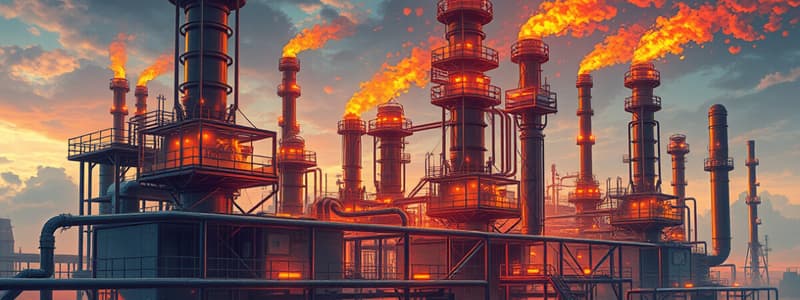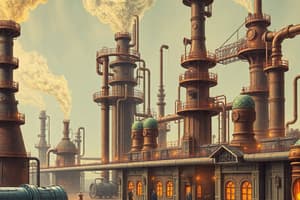Podcast
Questions and Answers
What is the primary purpose of the catalyst stripper in the catalytic cracking process?
What is the primary purpose of the catalyst stripper in the catalytic cracking process?
- To burn coke at high temperature
- To preheat the feed
- To separate products from catalyst particles (correct)
- To distill lighter fractions
The temperature required for catalytic cracking is below 500 °C.
The temperature required for catalytic cracking is below 500 °C.
False (B)
What is the typical temperature range for burning coke in the regenerator?
What is the typical temperature range for burning coke in the regenerator?
680°C - 720°C
The feed sent to the riser is typically composed of _____ distillation gas oil.
The feed sent to the riser is typically composed of _____ distillation gas oil.
Match the following components with their functions in catalytic cracking:
Match the following components with their functions in catalytic cracking:
What is the role of the catalyst particles in the catalytic cracking process?
What is the role of the catalyst particles in the catalytic cracking process?
The introduction of millisecond catalytic cracking (MSCC) minimizes non-selective post riser cracking.
The introduction of millisecond catalytic cracking (MSCC) minimizes non-selective post riser cracking.
How long does catalytic cracking typically take in the riser?
How long does catalytic cracking typically take in the riser?
The products from catalytic cracking are sent to the _____ for separation.
The products from catalytic cracking are sent to the _____ for separation.
What is the common feed rate for the riser in the catalytic cracking process?
What is the common feed rate for the riser in the catalytic cracking process?
What is the primary reason for performing vapor stripping in catalytic cracking?
What is the primary reason for performing vapor stripping in catalytic cracking?
Catalytic cracking processes utilize raw materials that come only from distillation under vacuum.
Catalytic cracking processes utilize raw materials that come only from distillation under vacuum.
What type of catalysts are used in the catalytic cracking process to achieve high yields?
What type of catalysts are used in the catalytic cracking process to achieve high yields?
The process of catalytic cracking can lead to the production of __________ molecules with high value.
The process of catalytic cracking can lead to the production of __________ molecules with high value.
Match the following catalysts with their characteristics:
Match the following catalysts with their characteristics:
Which of the following is a step that follows the recovery and separation of products in catalytic cracking?
Which of the following is a step that follows the recovery and separation of products in catalytic cracking?
The cationic mechanism involves the addition of a catalyst to a double bond, resulting in unsaturated hydrocarbons.
The cationic mechanism involves the addition of a catalyst to a double bond, resulting in unsaturated hydrocarbons.
What happens during the propagation step of the cationic mechanism?
What happens during the propagation step of the cationic mechanism?
Catalysts used in catalytic cracking like zeolites have a yield of __________ part of the initial feedstock.
Catalysts used in catalytic cracking like zeolites have a yield of __________ part of the initial feedstock.
What process can remove sulfur compounds during hydrotreating?
What process can remove sulfur compounds during hydrotreating?
Nitrogen species can generate sulfur during the catalyst regeneration process.
Nitrogen species can generate sulfur during the catalyst regeneration process.
Name the catalyst types commonly used in hydrotreating.
Name the catalyst types commonly used in hydrotreating.
The removal of unwanted species in hydrotreating is performed at a pressure range of _____ atm.
The removal of unwanted species in hydrotreating is performed at a pressure range of _____ atm.
Match the following pollutants with their associated removal methods:
Match the following pollutants with their associated removal methods:
Which of the following statements is NOT true regarding sulfur and catalyst activity?
Which of the following statements is NOT true regarding sulfur and catalyst activity?
Hydrotreating can help in upgrading lube oil properties under mild conditions.
Hydrotreating can help in upgrading lube oil properties under mild conditions.
What are the major effects of arsenic on the Pt catalyst?
What are the major effects of arsenic on the Pt catalyst?
Organometallic compounds transform into _____ metals that can reduce catalyst activity.
Organometallic compounds transform into _____ metals that can reduce catalyst activity.
Match the type of hydrotreating with its purpose:
Match the type of hydrotreating with its purpose:
What is the primary target of the deasphalting process?
What is the primary target of the deasphalting process?
The extraction and phase separation rates of supercritical fluids are lower than those of typical extraction processes.
The extraction and phase separation rates of supercritical fluids are lower than those of typical extraction processes.
What is the extracted material called in the deasphalting process?
What is the extracted material called in the deasphalting process?
Hydrocarbon supercritical solvents, such as _____, are used in modern extraction processes.
Hydrocarbon supercritical solvents, such as _____, are used in modern extraction processes.
Match the following terms related to the deasphalting process:
Match the following terms related to the deasphalting process:
What is the yield range for deasphalting processes?
What is the yield range for deasphalting processes?
Increasing the yield of the deasphalting process decreases the metal content in the extracted oil.
Increasing the yield of the deasphalting process decreases the metal content in the extracted oil.
What is a major benefit of the ROSE process?
What is a major benefit of the ROSE process?
The original deasphalting process operated at _____ psig.
The original deasphalting process operated at _____ psig.
What is the purpose of adding heat in the extraction stage of the deasphalting process?
What is the purpose of adding heat in the extraction stage of the deasphalting process?
What is the primary benefit of co-feeding small amounts of water to the reactor?
What is the primary benefit of co-feeding small amounts of water to the reactor?
Gasoline blending typically requires a mixture of 10–12 blendstocks.
Gasoline blending typically requires a mixture of 10–12 blendstocks.
What are the primary physical properties monitored during product blending?
What are the primary physical properties monitored during product blending?
The _____ step involves separating isooctene from the unreacted feed.
The _____ step involves separating isooctene from the unreacted feed.
Match the following terms with their definitions:
Match the following terms with their definitions:
Which of the following is NOT a characteristic of refined products that is analyzed and monitored?
Which of the following is NOT a characteristic of refined products that is analyzed and monitored?
Flashcards are hidden until you start studying
Study Notes
Catalytic Cracking Process
- Catalytic cracking involves cracking, recovery and separation of products, and catalyst regeneration.
- Raw materials include vacuum distillation products and bitumen residues without asphaltenes.
- Major products are light diesel (low aromatics) and heavy diesel (high aromatics), utilized as fuel.
Catalyst Poisoning and Regeneration
- After cracking, catalysts can be poisoned by tar and carbon residues.
- Vapor stripping and high-temperature air combustion remove poison from catalysts.
- American refineries use amorphous silica-alumina (70% yield) and crystalline zeolite (85% yield) catalysts.
Carbocationic Mechanism
- Catalytic reactions employ a carbocationic mechanism due to acidic catalysts.
- Unsaturated hydrocarbons react via Markovnikov addition, while paraffins lose hydride ions to form conjugated bases.
Catalyst Types and Performance
- Synthetic amorphous aluminosilicates were the first catalysts used for good reactivity and high conversion rates.
- Catalyst regeneration requires high temperatures to burn coke buildup without needing a furnace.
Riser and Reaction Conditions
- Preheated feed enters a riser (60m long, 1-2m diameter), where catalytic cracking happens within 2-4 seconds.
- Reaction temperatures exceed 500°C, obtained by heating coke and contact with hot catalyst particles.
Catalyst Stripper and Product Separation
- A catalyst stripper utilizes steam to remove products from catalyst particles, assisted by cyclones.
- Products are sent to a fractionator for distillation, separating lighter fractions from heavier oil.
Innovations in Catalytic Cracking
- Millisecond catalytic cracking (MSCC) improves gasoline selectivity by minimizing non-selective reactions.
- Contaminants like sulfur, nitrogen, oxygen, and arsenic can poison catalysts, necessitating removal processes.
Hydrotreating Process
- Hydrotreating removes sulfur and other compounds, preventing catalyst poisoning.
- Employs catalysts like Co-Mo, Ni-Mo, or Ni-W at pressures of 5-20 atm.
Deasphalting Techniques
- Deasphalting separates hydrocarbons based on different solubilities; yields between 75%-80%.
- Residuum Oil Supercritical Extraction (ROSE) uses supercritical solvents and offers high yield with lower energy costs.
Process Optimization
- Higher temperatures (up to 900°C) and short reaction times increase desired product yields.
- Various parameters must be optimized for effective hydrocarbon conversion and product yield.
Gasoline Blending
- Product blending requires combining multiple streams to meet standards for refined products.
- Finished products are monitored for physical, chemical properties, and performance characteristics, ensuring compliance with industry regulations.
Studying That Suits You
Use AI to generate personalized quizzes and flashcards to suit your learning preferences.




